Tested: 2004 V-8 Luxury SUV Comparison

From the November 2003 issue of Car and Driver.
It is true we were in Ohio immediately preceding the Great Blackout of '03, in which, tragically, the milk of perhaps millions of Americans went badly sour.
But we categorically deny that we had anything to do with causing it. Perhaps it was caused by faulty transmission lines—no one had claimed responsibility by the time we went to print. It is also possible the failure was sparked by a lightning bolt from above after He found out about the "Cornhole Tournament" taking place at a bar in downtown Athens. The Supreme Court might be more permissive than in years past about what goes on behind closed doors, or in the saloons of an Ohio college town, but we're not sure it's all sitting well with the ghostwriter of the Good Book.
The do-gooders would say the root cause is that every single American just cranks up the A/C and leaves every TV and light on in the house, all the while running a small industrial concern in the basement. Maybe they're right. Maybe we all are overpowered and overpampered. But does the Do-Gooder and Hand Wringer home office not have air conditioning?
The purpose of our little road trip was to get to the heart of this matter and test the relative merits of the hottest niche within a segment of the ever-burgeoning sport-utility class: sporty, on-road-oriented SUVs designed primarily for an American audience that is overendowed with power (the ante to get into this game was 300 horsepower) and bursting with every imaginable device for pampering its well-heeled occupants but offering no more room for cargo than a routine-sized station wagon.
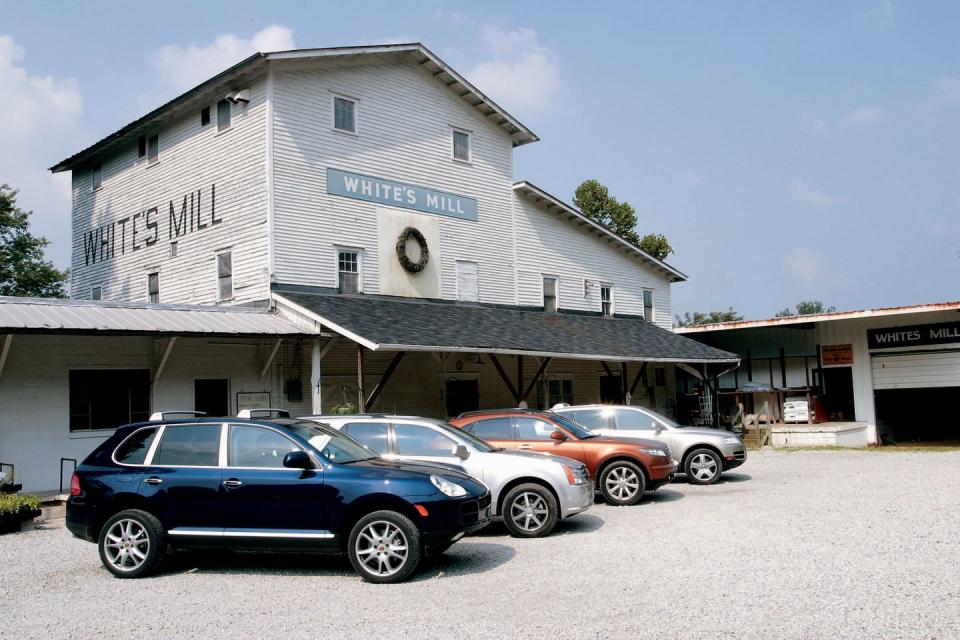
All told, we had 1280 horsepower split fairly evenly among the four V-8 engines that power the Cadillac SRX (320 hp), the Infiniti FX45 (315), the Porsche Cayenne S (335), and the Volkswagen Touareg (310). With the equivalent of 954 kilowatts of electric power pumping from these pumped-up utes, we could have powered a sizable neighborhood. Until we ran out of gas, which, in a group that averages 15 mpg, wouldn't take long. But, you know, screw that! It's our power, after all, and we're going to use all of it as often as we want. We would crank the air-conditioning units to full chill, play with the navigation systems, adjust our power seats, raise power-adjustable suspensions for no reason at all, and still sprint to 60 mph in an average of seven seconds just because we could. You wouldn't have?
We would not go off-road, though, because, well, why would we? Sure, all these vehicles have all-wheel drive, but even the kid at an Athens plant store recognized them as "a buncha fancy wagons." The Cadillac and the Infiniti are based on sports sedans (the CTS and the G35, respectively), not pickup trucks. The Porsche and the VW, which were designed together and share many parts, do have low-range gearing (just like a Jeep CJ7!) and air bladders that will raise their bodies until they look really silly. These add cost and weight (you can order either vehicle without the air suspension), which is unfortunate for the Germans. Also, both came with high-performance street tires with shallow tread that would have hobbled even a Hummer, off-road, anyway. Besides, off-roading is so uncomfortable.

Perhaps by now you've noticed the absence of one key competitor, the BMW X5. It was the X5 that first carved this little performance niche out of the lumbering masses of utility. There are a few reasons for its absence. The X5 has competed in two comparison tests and failed to win either—most recently, a VW Touareg surpassed it. The X5's V-8 is 10 shy of the requisite 300 horses. And soon—but not yet—it will have 325 horsepower. For 2004, the X5 gets the six-speed automatic and higher-hp, 4.4-liter V-8 from the 7-series, along with a new all-wheel-drive system. But we could not obtain a test vehicle so outfitted, and running an old one so shortly before substantial improvements would be helpful to no one.
Other V-8 utes such as the Lexus GX470 and Buick Rainier have either scored low in a previous comparo or are lacking the sporting gene. And the V-6—powered utes? They're out. This is not about merely adequate power, modesty, or reason.
Fourth Place: Volkswagen Touareg V-8
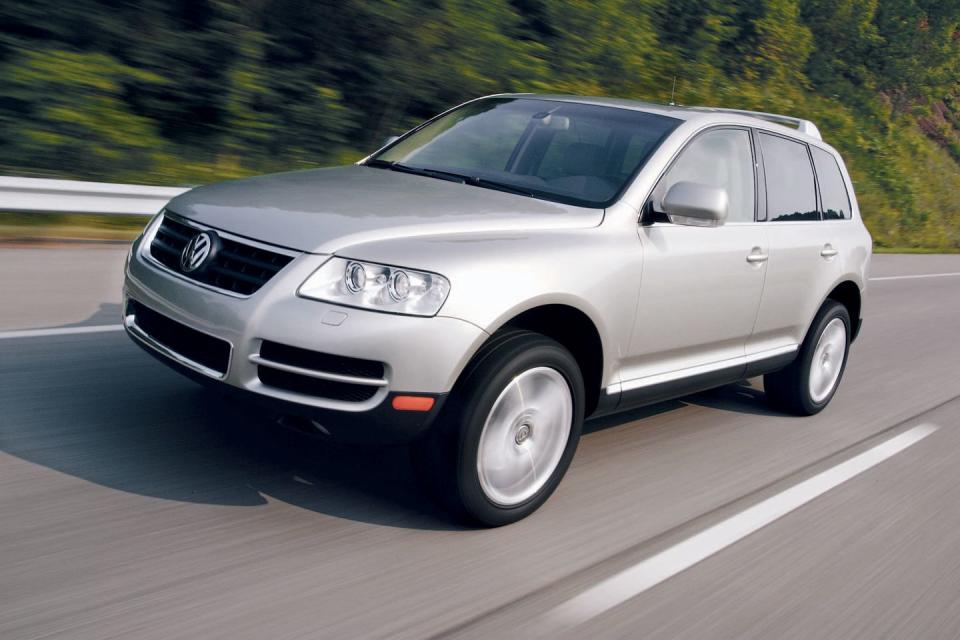
Hey, we didn't expect it to turn out this way, either. So save your outraged e-mails and allow us to explain how this VW V-8 could go from a convincing first-place finish in its first comparo ("The Bradsher Bunch," January 2003) and a spot on our 5Best Trucks list to the cellar in less than one year's time.
The most compelling reason: competition. None of the competitors assembled here was available for last January's eight-truck flog. Half the vehicles in the previous comparo were powered by six-cylinder engines, which made the VW's 310-hp V-8 seem like a nitro-burning dragster. You might ask why sixes were mixed with eights, but that's the way the pricing came out. Besides, it's our magazine, not yours, so zip it. In this test of utes, which is more focused on performance, the VW's Audi-sourced V-8 was the weakling. And with a hefty 5412-pound curb weight, the Touareg had the worst weight-to-power ratio of this group (17.5 pounds for each VW horse to pull, compared with 14.3 for the Infiniti). Also, although the Touareg might carry the second-lowest as-tested price at $53,265, that's still $6765 more than what VW led us to believe the last time around.
HIGHS: Faultless interior execution, rock-solid structure, great-sounding stereo.
LOWS: Inattentive throttle, feather-light and uncertain steering, reluctant handler.
Still, we hardly consider the Touareg the loser. Every test driver determined the VW luxury liner to be the finest choice for a long interstate haul. It is smooth in the extreme. Its transmission shifts are utterly without tactile or aural shock. Its ride quality has not a hint of harshness (assuming you leave the three-way-adjustable shocks out of sport mode). And as we've noted before, its interior trimmings and attention to detail trump almost any other car's on the market. You feel it in the beautifully rendered articulating hinges for the center-console-bin lid. In the tight seams between every piece of trim. In the brushed alloy threshold plates under all the doors. It is one seriously, almost obsessively, polished machine.
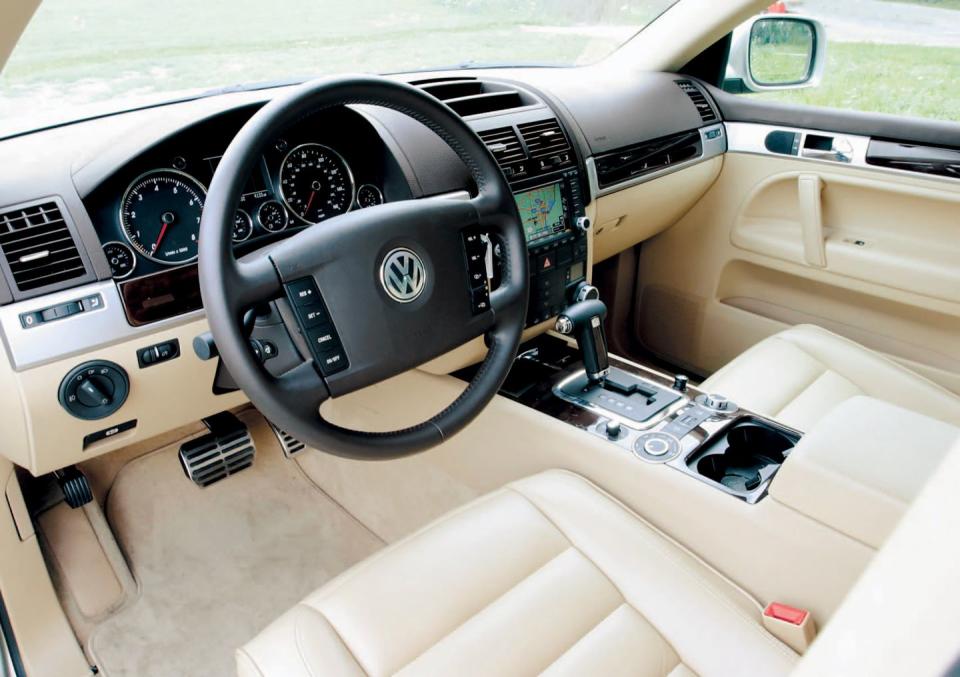
While VW's finishing school polished the Touareg into a debutante of taste and grace, it also made it seem a bit aloof. Raw displays of speed and handling are tawdry. And it can no more successfully disguise its excess weight than do those skirted bathing-suit bottoms on women with the same problem. The five-valve V-8 is smooth and purrs demurely at high revs. It's hard, though, for even an excellent engine to shine when buried in such a weighty pile of metal. It doesn't help that when you prod the throttle, you feel as if the message has to walk down the hall, open the engine-bay door, and slowly wake up the sleeping motor.
Although the motor can at least keep the Touareg in the hunt, the chassis is another story. Sophisticated it might be with its adjustable shocks and air springs, but you feel every ounce of this machine when it's time to turn. Its body leans and floats more than any of the others in this test. Its mass pushes relentlessly. Its superlight steering feels slow and dull. It has no appetite for vigorous driving—it's hesitant and uncertain. It rolls enough that a 20-ounce bottle of lemonade tumbled out of the shallow cup holder, skidded across the passenger seat, and slammed into the door panel.
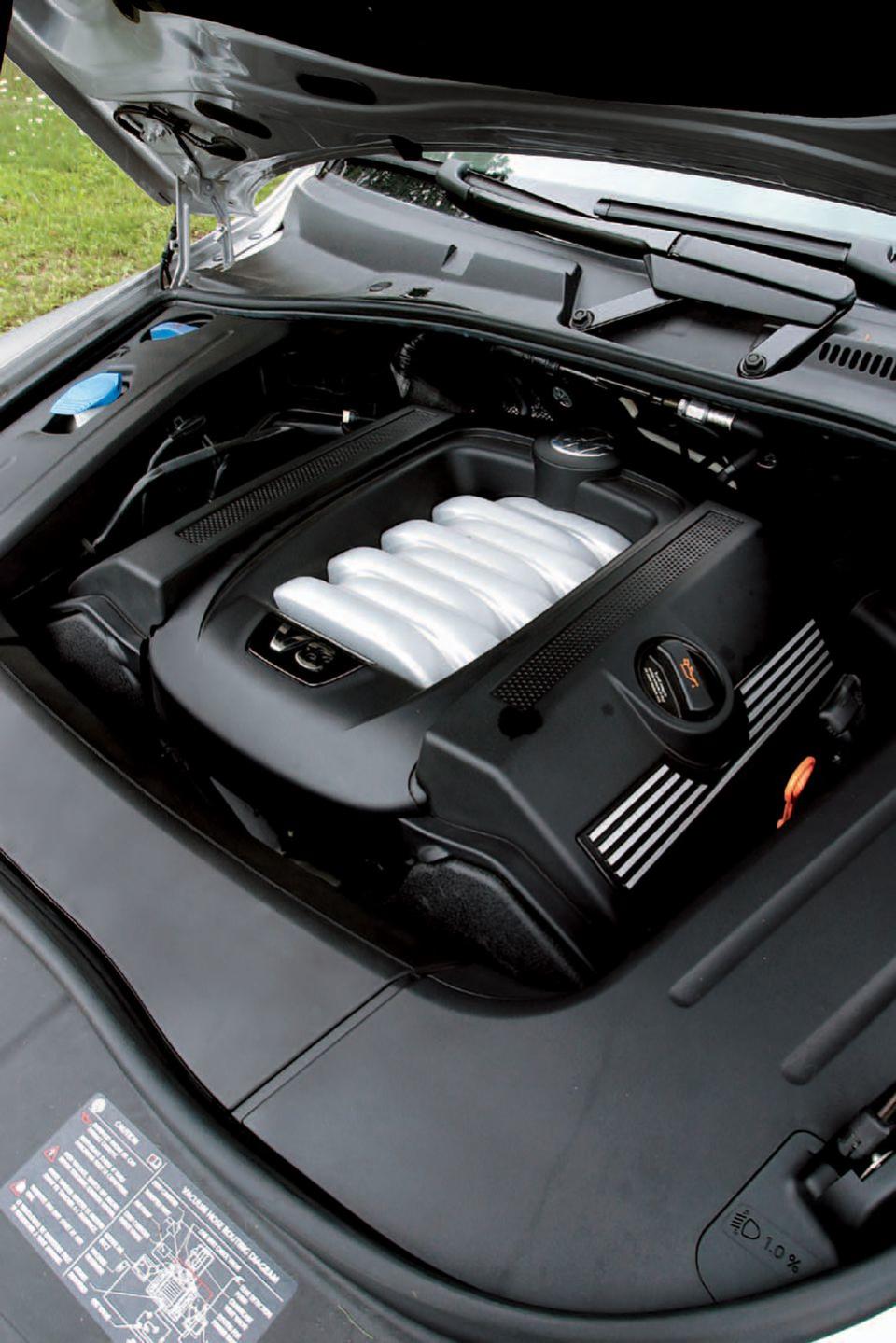
Ultimately, the Touareg has decent grip, even by the high standards of the group. With the second-widest tires here, the Touareg circled the skidpad faster than the Cadillac. At 0.82 g, though, the VW couldn't match the sportier Infiniti and Porsche. Its speed through our lane change trailed the Porsche's and the Cadillac's by 3.2 mph and 1.9 mph, respectively—and that's a lot. The Infiniti's speed is another story for later. On the road, the VW makes a labor of what in the other vehicles is a pleasure: driving swiftly.
THE VERDICT: A sophisticated and serene cruiser for those who don't need much "sport" in their utility vehicle.
And the Touareg provides no better people- and cargo-carrying capability than the FX45 and the Cayenne. All three trail the Caddy. And despite the luxury trimmings, the Touareg scored last for rear-seat comfort because of its hard seats, lack of thigh support, and slightly less headroom than in the Cayenne. If what you're looking for is a brilliantly constructed luxury car with a big trunk, room for four, and a convincing sport-ute visage, few compare with the Touareg.
2004 Volkswagen Touareg V-8
310-hp V-8, 6-speed automatic, 5412 lb
Base/as-tested price: $41,315/$53,265
Towing capacity: 7700
Cargo, behind front/rear: 71/31 cu ft
C/D TEST RESULTS
60 mph: 7.5 sec
100 mph: 20.1 sec
120 mph: 33.7
1/4 mile: 15.7 sec @ 89 mph
Braking, 70-0 mph: 184 ft
Roadholding, 300-ft-dia skidpad: 0.82 g
C/D observed fuel economy: 15 mpg
Third Place: Infiniti FX45

"I can't find the comfort setting for the suspension on this thing" came the mock-desperate voice over our two-way radios. Mock because the speaker was painfully aware that the Infiniti FX45's suspension is not adjustable and therefore has no comfort setting. It's the sport-utility vehicle focused most clearly on sport.
And the striking styling advertises that quite clearly. Infiniti says the FX45 looks like a bionic cheetah, which it doesn't (even if we had the remotest clue what a bionic cheetah looked like). It looks more like a very perturbed Argentine horned frog—you know, one of them wide and round fellas. And that's not a dig. It is flamboyant, and everyone notices it. Look at its brawn; its broad shoulders. Look at how the wheel wells are crammed to overflowing with the 20-inch wheels in a manner more consistent with a BMW M3 than a Ford Explorer. Notice how short the side windows are, as if its roof were chopped by a fan of lead-sled Mercurys. It's a look that borrows nothing from the established SUV handbook.
HIGHS: Quick, weighty steering; flat cornering; panache; the only navigation system that worked worth a damn.
LOWS: No comfort setting.
So it shouldn't come as a surprise that the FX rides as if it didn't have enough cartilage in its knees. The FX telegraphs to its driver the choppy pavement it's traversing in a Morse code of vibration and noise. Infiniti promises a gentler suspension tune for the '04 model, an example of which was not available for this test.

The payoff for the crusty ride is a shocking resistance to body roll compared with any ute, save perhaps the Cayenne. The FX45 tied the Cayenne for champ of the skidpad at 0.85 g. Its result through our emergency lane change—the lowest speed in the test--requires some explanation. With its standard-equipment stability-control system switched off, the FX's rear desperately wants to snap around. Our track tester called it "pure evil," but he's exaggerating. The FX's fastest run was done with the stability-control system turned on, which almost always lowers a vehicle's speed. On the road, driven at anything less than full-tilt gonzo fast, the Infiniti is quite satisfying. Twist the small-diameter steering wheel, and you're rewarded with immediate turn-in. It is a little heavy for some tastes, but it suited a few of us perfectly.
As the relative pencilneck of this group at 4492 pounds and with a 315-hp, 4.5-liter V-8 propelling it, the FX is the quickest to 60 mph and almost dead even with the Cadillac through the quarter-mile. The engine snarls provocatively at the first touch of the well-calibrated throttle. You could say that the FX45 is the Porsche of SUVs. The five-speed automatic makes good use of the power and shifts with firm authority—although its manumatic function is not as responsive as that of the Porsche or VW.
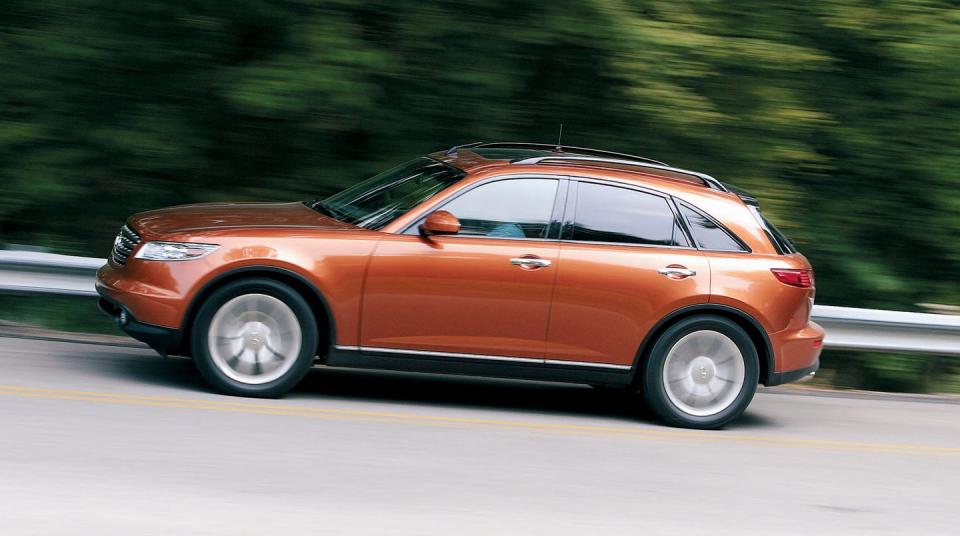
In keeping with its sporty persona, you tuck yourself within the FX45. Its short windows and sloping roof make it a cocoon. The utter blackness of the upper part of the cabin closes in on you. This makes you feel either cosseted, as in a sports coupe, or claustrophobic. With seats and trimmings the color of an overripe pumpkin, the inside is as curious-looking and polarizing as the rest of the FX. The quality of the materials is not up to the standard set by the Touareg (surprised?), and some pieces, such as the dual center armrests, feel downright cheap.
But there are victories in the interior as well. The pockets in the front doors are bottom-hinged, as in an Audi A6, so you won't scrape your knuckles grabbing a map. And you may not even need a map, since the Infiniti's nav system was the only one of the bunch that could reliably lead us to our hotel. The FX is also the only vehicle in the group that will drop its rear seatbacks at the pull of two levers mounted in the cargo area. The cushy rear seats have reclining seatbacks for proper lounging, and the FX45 scored the most points for comfort. None of these vehicles was designed as a workhorse, and the FX's focus on sporty looks limits cargo-carrying ability. But it is, at least, comparable to the Germans.
THE VERDICT: A sports coupe wearing a backpack. That's what you asked for, right?
In this class, the FX rates as something of a bargain. As optioned, it was the cheapest SUV in the test, albeit by a small margin. But we had to load on the $7600 Technology package just to get the price up to compete in this group. That includes the navigation system, a rearview camera, and the "Intelligent Key," which allows the owner to start the vehicle without inserting a key into the ignition. You could do without much of this electronic trickery except that it's the only way to get the nav system. On the strength of its performance, value, and flamboyance, the Infiniti placed but one tiny little point below the Porsche. Be aware, though, that the FX45 has an intense flavor and will turn off some people as intensely as it turned most of us on.
2004 Infiniti FX45
315-hp V-8, 5-speed automatic, 4492 lb
Base/as-tested price: $44,770/$52,670
Towing capacity: 3500
Cargo, behind front/rear: 65/27 cu ft
C/D TEST RESULTS
60 mph: 6.4 sec
100 mph: 17.5 sec
120 mph: 32.6
1/4 mile: 15.0 sec @ 93 mph
Braking, 70-0 mph: 177 ft
Roadholding, 300-ft-dia skidpad: 0.85 g
C/D observed fuel economy: 17 mpg
Second Place: Porsche Cayenne S

Chief among several reasons that this Porsche didn't win a comparison test of performance vehicles can be best expressed by seven simple keystrokes: $68,760. That's the as-tested price of our well-equipped test vehicle. That's $14,620 more than the next priciest vehicle, the Cadillac, and $16,090 more than the cheapest, the Infiniti.
Here are some more pertinent digits: 5612. That's the curb weight of the Cayenne--200 pounds more than the Touareg and greater by more than half a ton than the Cadillac or Infiniti. Possibly this may be because Porsche carves the Cayenne out of a block of depleted uranium.
HIGHS: Better tuned for vigorous driving than its VW sibling; sonorous, powerful V-8; excellent manumatic operation; cute key fob.
LOWS: Porsche logo adds a 15-grand penalty, curb weight is nearly as heavy as its price, not as quick as a Cadillac.

It takes every bit of the Porsche's excellent 335-hp, 4.5-liter V-8 just to propel all this Porscheness to third-place acceleration times. A 0-to-60-mph sprint of 7.3 bests the VW but is still 0.3 second slower than the test average. When was the last time that could be said of a Porsche?
Interestingly, even though the Touareg and the Cayenne were designed in tandem, the magicians at Porsche HQ have achieved what those at VW could not: an apparent weight loss the moment the road turns curvy. In a blind taste test, even an experienced Porsche driver wouldn't likely recognize the Cayenne as a Porsche by its driving characteristics or feel. Still, it's much more satisfying to drive than the VW. It all comes down to tuning. The two share most of their major components, including suspension configuration, transmission, and steering system. Yet the Porsche's steering is alert and trusty, whereas the VW's is dazed. There is an accuracy to the Cayenne's moves that is only a very recent addition to the sport-ute repertoire. It resists body roll to a far greater degree than the VW without sacrificing too much ride quality. Only when you choose the dampers' sport setting does the Cayenne hop on undulating pavement.
With big meats and the aforementioned body control, the Cayenne squirted through our emergency lane change quickest of all. Like the Touareg's, the Porsche's manumatic function is quicker to react to your command than the others. Using the same size brake discs as the VW, the Porsche—with a slightly larger tire contact patch and less brake dive—stops six feet shorter from 70 mph than the Touareg. At 178 feet, the Cayenne took only one foot more than the test's best stopper, the FX.

Where the Porsche falters, other than in weight and price, is where the VW succeeds--the interior. The Cayenne's plastic textures look more like big wrinkly elephant skin than grainy leather. The trim that covers the inside of the A-pillars doesn't live up to the vehicle's luxurious sticker price, and it doesn't fit correctly. Some of the climate controls are covered by a flimsy-feeling and pointless lid. And even at its lofty price, the Porsche doesn't feature a power-adjustable steering wheel, and it's the only vehicle in the group without a rearview mirror that dims automatically (it's available in an $890 package).
THE VERDICT: It's a Touareg Super Sport.
Our often-enthusiastic staffers rated the Cayenne higher than the Touareg because of the Porsche's better road manners and higher than the FX45 because of the Cayenne's greater level of sophistication. Of course, none of us was paying the extra $15,000 for it, either.
2004 Porsche Cayenne S
335-hp V-8, 6-speed automatic, 5612 lb
Base/as-tested price: $56,665/$68,760
Towing capacity: 7700
Cargo, behind front/rear: 63/19 cu ft
C/D TEST RESULTS
60 mph: 7.3 sec
100 mph: 18.8 sec
120 mph: 31.6
1/4 mile: 15.4 sec @ 92 mph
Braking, 70-0 mph: 178 ft
Roadholding, 300-ft-dia skidpad: 0.85 g
C/D observed fuel economy: 15 mpg
First Place: Cadillac SRX V-8

That the all-new SRX won this contest against such premium competition says worlds about the progress at GM's luxury division. Interior space is the only category in which the SRX soundly defeated the others—its wheelbase is four inches longer and its overall length is six to eight inches longer than the others. The Caddy is the only one that can fit a third row of seats—although our test vehicle came with a nifty concealed-cargo organizer in place of the optional seating.
Otherwise, the SRX succeeds by not faltering badly at any task. It is the best combination of a satisfying driving experience and utility.
HIGHS: Long wheelbase provides excellent ride and interior roominess, an engine to be proud of, fluid handling.
LOWS: High doorsills, poorer fit and finish than in the Germans, occasional driveline lash.
The Cadillac is also unique in the group for having the least-convincing sport-ute visage. It's as tall as any of the others, but its extended length and narrow body make the SRX look like what it is: a tall station wagon, an impression reinforced by its carlike driving position and sloping hood. This bothers us not one whit.

It weighs 102 more pounds than the Infiniti, but propelled by five more horsepower, the Caddy is plenty quick. It loses the 0-to-60-mph sprint to the FX by 0.3 second, but by 80 mph, the two are even. Beyond that, the Cadillac starts inching away. Its 4.6-liter engine speaks with a less raucous voice than the FX's engine, and it's as smooth as anything else in the test. The shifts from the five-speed manumatic are buttery. The only thing marring a stellar powertrain performance was a couple of instances of driveline lash—a loud "thunk" at low speeds when abruptly changing the throttle input.
The SRX's suspension, using coil springs and magnetic, automatically adjustable dampers, strikes a pleasant balance between comfort and sport. It tied with the Touareg for best ride quality. Unlike the VW, though, the SRX is fluid through the twisty stuff. Certainly, this Cadillac rolls more than the Infiniti or Porsche, and its steering is notably slower. Yet the SRX is utterly predictable, its roll is reassuringly progressive, and its steering allows you to pour the car smoothly into corners. Its throttle and brake pedals are ideally tuned for smooth operation. And did we mention that the SRX's cargo space is the only one here that's significantly larger than that of the full-size station wagons we tested back in 1999?
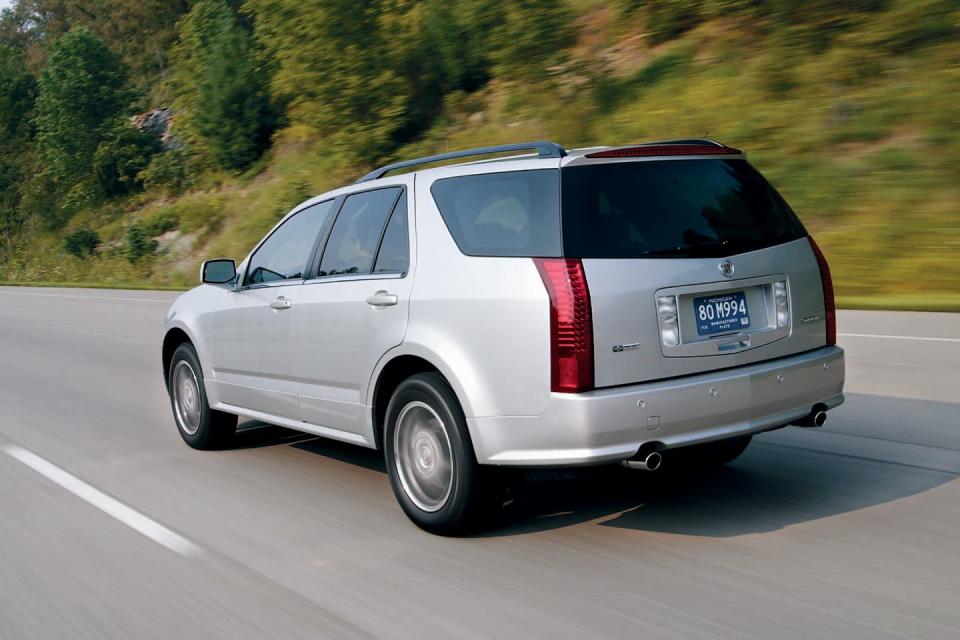
We're not yet ready to call Cadillac's renaissance complete. The company still has some work to do on the appearance of its interiors. It claims it spends as much as the top competitors. If that's true, Cadillac should be getting more for its money. Although the SRX's layout has a pleasing simplicity compared with the sea of buttons in the other trucks, the sheen of the materials looks low-cost, and the faceplate around the shifter moves slightly when you shift aggressively. We chalk up the Caddy's 0.77-g reading around the skidpad (poorest of the pack) and slightly long 187-foot braking distance to its wearing the smallest tires. But both numbers are perfectly respectable. And grip isn't everything, as evidenced by the SRX's second-best emergency-lane-change run.
THE VERDICT: The station wagon with the best combination of sport and utility.
At a lower price, the Cadillac might have been the runaway winner. At $54,140, it's not a bargain. But it is the only one of the group that can be had in rear-wheel-drive form, which would save you $1900. By Cadillac's Byzantine options list, though, if you simply want the nav system, you'll have to pony up $7145 for a package that also includes all-wheel drive, magnetic ride control, a stereo upgrade, and HID headlamps. The buffet-line approach is always better. Maybe I want the Tater Tots but not the baked scrod.
Oh, hell, give us both. It's only money.
2004 Cadillac SRX V-8
320-hp V-8, 5-speed automatic, 4594 lb
Base/as-tested price: $46,995/$54,140
Towing capacity: 3500
Cargo, behind front/rear: 70/32 cu ft
C/D TEST RESULTS
60 mph: 6.7 sec
100 mph: 17.3 sec
120 mph: 32.4
1/4 mile: 15.1 sec @ 94 mph
Braking, 70-0 mph: 187 ft
Roadholding, 300-ft-dia skidpad: 0.77 g
C/D observed fuel economy: 13 mpg
You Might Also Like

 Yahoo Autos
Yahoo Autos 